Lightfoot Baseball Club
 The Lightfoot Baseball Club was the earliest known secular social outlet in which Thomas Woodrow Wilson participated. The club, organized in the late 1860s by a group of neighborhood boys in the old residential section of Augusta, is remarkable for the leadership it would ultimately represent in the larger world.
The Lightfoot Baseball Club was the earliest known secular social outlet in which Thomas Woodrow Wilson participated. The club, organized in the late 1860s by a group of neighborhood boys in the old residential section of Augusta, is remarkable for the leadership it would ultimately represent in the larger world.
“Tommy” Wilson served as the club’s president, writing a set of bylaws under which the boys operated, and requiring Parliamentary Procedure in their meetings. This is the first known instance of future President Wilson actually being a president of any organization. He would continue to lead, write bylaws and constitutions and reorganize the organizations and governments that he represented for the rest of his life, and ultimately attempt to organize the entire world through the ill fated League of Nations.
We know the names of the boys who played on the team from two line-ups 13-year old Tommy Wilson himself wrote in one of his textbooks, now in the Woodrow Wilson Papers held by the Library of Congress. These scions of some of Augusta’s most prominent families after the War Between the States were participating in a fad that was sweeping the nation in that period – baseball. Several of them were students at Professor Joseph Tyrone Derry’s Select School for Boys near the corner of McIntosh (7th) and Bay Street.
It is believed that the Clark brothers, Amos and Johnny, brought the game to Augusta when they returned from high school in Elizabeth, New Jersey. Their little brother, Clarence, was a member of the Lightfoots. Neighborhood teams were formed that played against one another at the parade ground next to Richmond Academy on Telfair Street. The Lightfoots met in the hayloft of the Wilson’s carriage house, as well as in the garret of the Lamar’s home next door to the Wilsons.
Just as the members of the Lightfoot Baseball Club were the closest friends of Tommy Wilson when he was living in Augusta in the 19th Century, the Lightfoot Society is conceived as being made up of the closest friends of his restored Augusta home in the 21st Century. Perhaps it will be of interest to know something of the original Lightfoots, and what they ultimately did with their lives. The sketches that follow synopsize what has been learned about each of the boys in the club, as well as other known close friends and schoolmates of President Woodrow Wilson when he lived in Augusta.
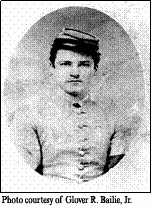 JAMES GLOVER BAILIE, JR. – PITCHER AND FIRST BASE
JAMES GLOVER BAILIE, JR. – PITCHER AND FIRST BASE
Born in Charleston July 28, 1856 and died in Augusta April 4, 1886 from consumption at the age of 29 years. Son of Irish Immigrants James Glover Bailie, Sr. (1820-1893) and Nancy Courtney (1828-1859), and grandson of Thomas Courtney (1794-1860), librarian of the Young Men’s Library Association. The family moved to Augusta permanently in the early 1860s. After his mother’s death his father married her sister, Margaret Courtney, who raised him. The Bailies and Courtneys were members of First Presbyterian Church. “Jimmie” Bailie grew up in the 400 block of Telfair Street in a house next to the Brahe House. His father was the proprietor of Bailie and Brother, dealers in carpets, oilcloths, window shades and wallpapers with locations in both Charleston and Augusta. Jimmie Bailie married in 1877 to Lula Williams Simmons (1857-1889), and they had four children. Jimmie had gone into business with his father before his untimely death. He is buried in Magnolia Cemetery in Augusta.
 CLARENCE EDGAR CLARK – CATCHER
CLARENCE EDGAR CLARK – CATCHER
Born in Edgefield County, South Carolina January 14, 1855 and died in Augusta on August 21, 1929. He was the son of John Mulford Clark (1813-1880) and Sarah Ann Elizabeth Butler (1823-1906), the former a native of Elizabeth, New Jersey and the latter a native of Augusta. Mr. Clark came to Georgia in the 1830s to improve his health, and settled in Augusta as a merchant. He later established a plantation and store in Edgefield County, and it is for him that Clark’s Hill, South Carolina is named. The Clarks returned to Augusta in the late 1850s, and lived in the 500 block of Greene Street next door to the courthouse. Clarence Clark’s elder brothers, Amos and Johnny, are credited with bringing the interest in baseball to Augusta after they returned from school in Elizabeth, New Jersey. Clarence worked for J. B. White Company and for his father at Clark Milling Company before going into the real estate business with John W. Dickey in 1890. He later established his own real estate firm. He married in 1896 to Mary Hollis Wadley (1866-1902), daughter of Moses Wadley, who lived on the corner of Walton Way and Fleming Avenue in Summerville. There were three children, none of whom married, and Clarence Clark has no direct descendants living today. He is buried in Summerville Cemetery in Augusta.
CHARLES CLAY COOKE – LEFT FIELD
Born September 14, 1855 in Augusta and died April 6, 1905 at Hasting-On-Hudson, New York at the age of 49 years from apoplexy. He was the son of Francis H. Cooke (c1803-1866) and Anna Redmond (1833-1902), both natives of New York. His uncle was Dennis Redmond, original proprietor of Fruitland Nursery and builder of the Augusta National Golf Clubhouse. His brother was Francis Redmond Cooke, another member of the Lightfoots. Charles Cooke lived with his family in the 500 block of Greene Street. His father owned and operated a well-patronized haberdashery on Broad Street, a business that Charles also entered as a young man. He never married and had no children. In the late 1880s he moved with his mother and sister to Hastings-On-Hudson, New York, where he died. His remains were returned to Augusta and interred in Magnolia Cemetery.
FRANCIS REDMOND COOKE – LEFT FIELD
Born in Augusta in about 1857 and died here in August 1887 at the age of 30 years from Typhoid Fever. He was another son of Francis H. Cooke and Anna Redmond, and a brother of Charles Clay Cooke, above. Like his brother, he continued his father’s haberdashery on Broad Street before his untimely death. He never married and had no children. He is buried with his parents and brother in Magnolia Cemetery in Augusta.
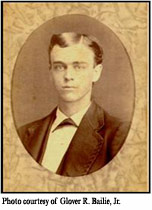 SAMUEL TRUE DENNING – 1ST BASE AND SHORT STOP
SAMUEL TRUE DENNING – 1ST BASE AND SHORT STOP
Born December 6, 1857 in Augusta, and died here on December 20, 1920. Son of David Harris Denning (1831-1885) and Maribah Read (1839-1919), both natives of New England. David Denning was a contractor and brick mason, and is credited with creating the wall around Magnolia Cemetery and furnishing the bricks for the original Sacred Heart Church. The Dennings lived at the southwest corner of McIntosh (7th) and Taylor Streets in a house that still stands. Sam Denning followed his father into the contracting business, and lived in Augusta for most of his life. He married in 1878 to Adelaide Hardman (1859-1912) and had four daughters. Late in life he remarried to Gertrude Buck in 1918, and had a son. He is buried in Magnolia Cemetery in Augusta.
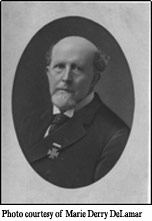 JOSEPH TYRONE DERRY – TEACHER
JOSEPH TYRONE DERRY – TEACHER
Born December 13, 1841 in Milledgeville and died January 5, 1926 in Jacksonville, Florida. He was the son of Augusta merchant William Cowan Derry (1816-1883) and Mary Alma Bunnell (1817-1889), and after graduating with honors from Emory at Oxford in 1860 served in the Oglethorpe Infantry during the Civil War. Derry opened his select school for boys in 1866 and also was principal at Houghton Institute following the war. He later was a teacher in the classical department at Richmond Academy, and followed a long and distinguished career in teaching in Macon and Atlanta. He also was a prolific author about Georgia and the Civil War. Derry married in 1862 to Elizabeth Dunning Osborne (1844-1927), and had seven children.
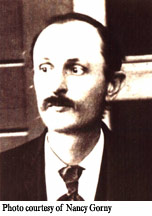 JAMES CHARLES DWELLE – RIGHT FIELD
JAMES CHARLES DWELLE – RIGHT FIELD
Born February 14, 1854 in Augusta and died January 23, 1917 in Fresno, California. He was a son of Lemuel Dwelle, Jr. (c1828-1869) and Clara A. Averell (1833-1919). The father was a native of Quincy, Massachusetts and was a dealer in shoes and boots on Broad Street. The mother was a native of Augusta, and the Dwelles were members of the Episcopal Church of the Atonement that was at 11th and Telfair. They lived on upper Greene Street until the family left Augusta after settlement of the father’s estate. Charles Dwelle moved to Boston, where he worked in the printers’ trade, following in the footsteps of his maternal uncle. Dwelle married Mary Alice White (1856-1925) in Waltham, Massachusetts on December 6, 1881. He later joined his family in Brooklyn, New York where he worked as a lithographer. In 1887 he moved his family to Easton, California near Fresno, where he ranched, raised grapes and continued working as an engraver and lithographer. His mother died in New York City, and her remains were returned to Augusta’s Magnolia Cemetery in 1920.
CHARLES C. FLEMING – 3RD BASE
Born in Richmond County about 1857 and died September 27, 1887 in Augusta, aged 30 years from consumption. The son of John Lowery Fleming (1815-1893) and Laura E. Cope (c1827-1862), he was a first cousin of William Henry Fleming, one of the students in Joseph Derry’s school. The father was listed variously as a cotton buyer, cotton merchant, cotton factor and cotton broker. The mother was from Savannah and was apparently a member of the Baptist Church, but joined the Episcopal Church of the Atonement on her deathbed. Charles Fleming was raised by a stepmother named Jane Crommelin. The Flemings lived in Woodlawn, a suburb of Augusta, but moved to the southwest corner of Greene and Centre (5th) Streets by 1872. Charles Fleming worked as a bookkeeper and a traveling salesman before his death. He never married. His funeral was held from First Christian Church in Augusta, and he is buried in Magnolia Cemetery, apparently in an unmarked grave.
 WILLIAM HENRY FLEMING – A STUDENT AT PROFESSOR JOSEPH DERRY’S SCHOOL
WILLIAM HENRY FLEMING – A STUDENT AT PROFESSOR JOSEPH DERRY’S SCHOOL
Born October 18, 1856 in Augusta, and died here June 9, 1944. He was the son of Porter Fleming (1808-1891) and Catherine Bathsheba Moragne (1822-1903). The father, originally from Lincoln County, was a wholesale grocery merchant in partnership with Charles A. Rowland, and later became a cotton factor and commission merchant. The mother was of a prominent French Huguenot family of old Abbeville District, South Carolina. The Fleming home was at “Westover,” where the cemetery of the same name is now located on Wheeler Road. Following its destruction by fire, the Flemings moved to 2 Cumming (10th) Street. W. H. Fleming was superintendent of Richmond County Public Schools and became a lawyer of note in Augusta. He served in the Georgia House of Representatives, and later was a Congressman from this district between 1897 and 1903. He married in 1900 to Marie Celeste Ayer (1875-1950) of Rome, Georgia, and they had two children. His columned mansion is still standing at 2631 Walton Way on The Hill in Augusta. He is buried in Summerville Cemetery in Augusta.
 THOMAS R. GIBSON – RIGHT FIELD AND CENTER FIELD
THOMAS R. GIBSON – RIGHT FIELD AND CENTER FIELD
Born about 1857 in Warrenton, Georgia and died in Syria in 1896 from Small Pox. He was the son of Dr. Sterling Gibson and Amanda Missouri Ray (c1837-1914), and was reared in Warren County. After the death of his father, he moved with his mother and brother to Augusta to live with an uncle, William Gibson, who was Judge of the Superior Court. Judge Gibson lived in the 600 block of Telfair Street, but later moved to 15th Street near Laney-Walker Boulevard. Thomas R. Gibson was an editor of the Augusta Evening News and was appointed United States Consul to Beirut by the Grover Cleveland administration in the early 1890s. He died while in diplomatic service in Syria. He probably never married nor had children.
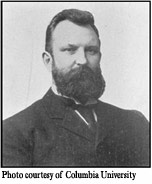 WILLIAM ALBERT KEENER – A STUDENT AT PROFESSOR JOSEPH DERRY’S SCHOOL
WILLIAM ALBERT KEENER – A STUDENT AT PROFESSOR JOSEPH DERRY’S SCHOOL
Born March 10, 1856 in Augusta and died April 22, 1913 in New York City. The son of Henry Keener (c1802-1860) an Augusta carpenter, and Isabella Colson (1819-1866) an Englishwoman, he was also raised by a stepfather, John Odom (c1813-1866). After the death of his parents, he joined the household of his married sister, Harriet and her husband John W. Rigsby, who was a grocer at 5th and Broad who also had a stall in the Lower Market. The Rigsbys lived on lower Broad Street. William Keener attended Emory College at Oxford, and Harvard Law School. He practiced law in New York City, and taught in the law schools at Harvard, Columbia and Fordham. He was Dean of the Columbia University law school from 1891-1901, and then filled an unexpired term in the Supreme Court of New York. He married in 1878 to Frances McLeod Smith of Somerville, Massachusetts. The William Albert Keener Chapter of Phi Alpha Delta legal fraternity at Emory University is named in his honor.
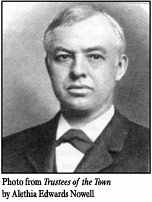 JOSEPH RUCKER LAMAR – 3RD BASE
JOSEPH RUCKER LAMAR – 3RD BASE
Born October 14, 1857 in Elbert County, Georgia and died January 2, 1916 in Washington, D.C. The son of the Reverend James Sanford Lamar (1829-1908) and Mary Margaret Rucker (1833-1864), the father was the pastor of First Christian Church in Augusta, which was then located in the 700 block of Reynolds Street. The Lamars lived in a manse provided by Emily Tubman on McIntosh (7th) street next door to the Wilson’s Presbyterian manse at 7th and Telfair. After being educated at private schools in Georgia and Maryland, the University of Georgia, Bethany College in West Virginia and Washington and Lee at Lexington, Virginia, Joe Lamar returned to Augusta where he set up an outstanding law practice with Henry Clay Foster. He served two terms in the Georgia legislature, and codified the laws of the State of Georgia. From 1903-1905 he served as an Associate Justice of the Georgia Supreme Court, and was appointed by President Taft to the Supreme Court of the United States in 1910. During his tenure as an Associate Justice on the high court, he was appointed by President Wilson to negotiate peace with Mexico, which averted war in 1914. He married in 1879 to Clarinda Huntington Pendleton (1856-1943), daughter of the president of Bethany College. They had three children. During most of his adult life he lived at 1209 Greene Street, now razed, but in 1905 the Lamars remodeled the large Neo-classical home that still stands at 1006 Johns Road. His remains were returned to Augusta and interred in Summerville Cemetery.
PHILLIP J. LAMAR – SHORT STOP
Born March 15, 1859 in Augusta and died here January 2, 1882, aged 22 years, from tuberculosis. Phil Lamar was a brother of Joseph R. Lamar and was raised in the Seventh Street manse of the Christian Church by his father and stepmother, Sarah Mayson Ford (c1837-1905), whose father Dr. Lewis D. Ford lived next door and was Dean of the Medical College of Georgia. Phil accompanied his brother Joe to all the same schools, and had just began his promising career as an attorney when his life was cut sadly short. It is said that he had as much potential as his elder brother, Joe. He was buried in Magnolia Cemetery.
 PLEASANT ALEXANDER STOVALL – FRIEND OF TOMMY WILSON
PLEASANT ALEXANDER STOVALL – FRIEND OF TOMMY WILSON
Born July 7, 1857 in Augusta and died May 14, 1935 in Savannah. He was the son of Bolling Anthony Stovall (1827-1887) and Martha Wilson (1836-1906), who lived in a house at 1211 Greene Street that still stands. The father was a commission merchant and the mother, a native of Africa, was the daughter of missionary parents. In the early 1870s Bolling Stovall moved to Athens, and worked for his brother’s Georgia Chemical Company as a traveling salesman. After college at the University of Georgia, Pleasant Stovall returned to Augusta and worked for the Augusta Chronicle, eventually becoming editor-in-chief under Patrick Walsh. In 1891 he moved to Savannah where he started the Savannah Press, an evening newspaper, which he continued to own until he sold it in 1931. As a respected journalist, he became one of the most influential men in Georgia, serving on numerous boards. He was appointed Ambassador to Switzerland by President Wilson, 1913-1919. In 1885 he married Mary Ganahl (1861-1951) of Summerville, and they had three children. Upon his death, his remains were returned to Augusta and interred in Summerville Cemetery.
THOMAS COMBS WALTON – PITCHER
Born July 22, 1855 in Augusta and died September 18, 1914 in Anderson, South Carolina. He was the son of Robert Walton, Jr. (1826-1908) and Virginia M. Combs (1833-1918) of Augusta. The family lived on Broad Street near the father’s wholesale grocery business, but later moved to The Hill and lived in the house that now forms the inner nucleus of the Partridge Inn on Walton Way and Hickman Road. “Tommy” Walton began as a bookkeeper in Augusta, but left town in the mid-1880s to pursue a long career as a school administrator. He worked as superintendent of schools in Shelbyville and Tullahoma, Tennessee, Okolona, Mississippi, Bradentown, Florida and Anderson, South Carolina. He was president of Margaret College in Versailles, Kentucky between 1907 and 1909, but as a widower returned to Anderson where he sold fire insurance at the end of his life. He married in 1878 to Sarah Twiggs Bryan (1859-1908), daughter of Confederate General Goode Bryan of Augusta and Anna Twiggs. They had one son. Thomas C. Walton is buried in Old Silverbrook Cemetery in Anderson.
THOMAS WOODROW WILSON – 2ND BASE
Born December 28, 1856 in Staunton, Virginia and died February 3, 1924 in Washington, D.C.. The son of the Rev. Dr. Joseph Ruggles Wilson (1822-1903) and Janet E . Woodrow (1826-1888), young “Tommy” Wilson moved to Augusta when he was 12 months old. His father was the Pastor of First Presbyterian Church in Augusta from 1858-1870 during the Civil War, in spite of his Ohio birth. His mother, born in England, was the daughter of a Presbyterian minister. After attending Professor Derry’s school in Augusta and receiving private tutoring in Columbia, Tommy Wilson went on to Davidson College and Princeton for his undergraduate work. He then went to the University of Virginia Law School, and after an unsuccessful year of practicing law in Atlanta, he returned to school to work on a PhD at Johns Hopkins University. He followed a teaching career at Bryn Mawr, Wesleyan and Princeton, and was selected President of the latter in 1902. In 1910 he was elected Governor of New Jersey, and in 1912 President of the United States. He served two terms between 1913 and 1921, and retired to a home in Washington. He was married in 1885 to Ellen Louise Axson (1860-1914) and had three daughters. His second wife, whom he married in 1915 was Mrs. Edith Bolling Galt (1872-1961). Woodrow Wilson is entombed in the National Cathedral in Washington, D.C.
Additional information is welcomed regarding any members of the original Lightfoot Baseball Club. Photos of the boys at any age, their parents, siblings, homes or related images, as well and any additional biographical information is eagerly sought. Such information will assist with the goal of creating an article and an exhibit about these remarkable young men, and it will help tell a forgotten chapter in the life of our 28th President.
Researched and written by Erick D. Montgomery
Revised 6/2003

